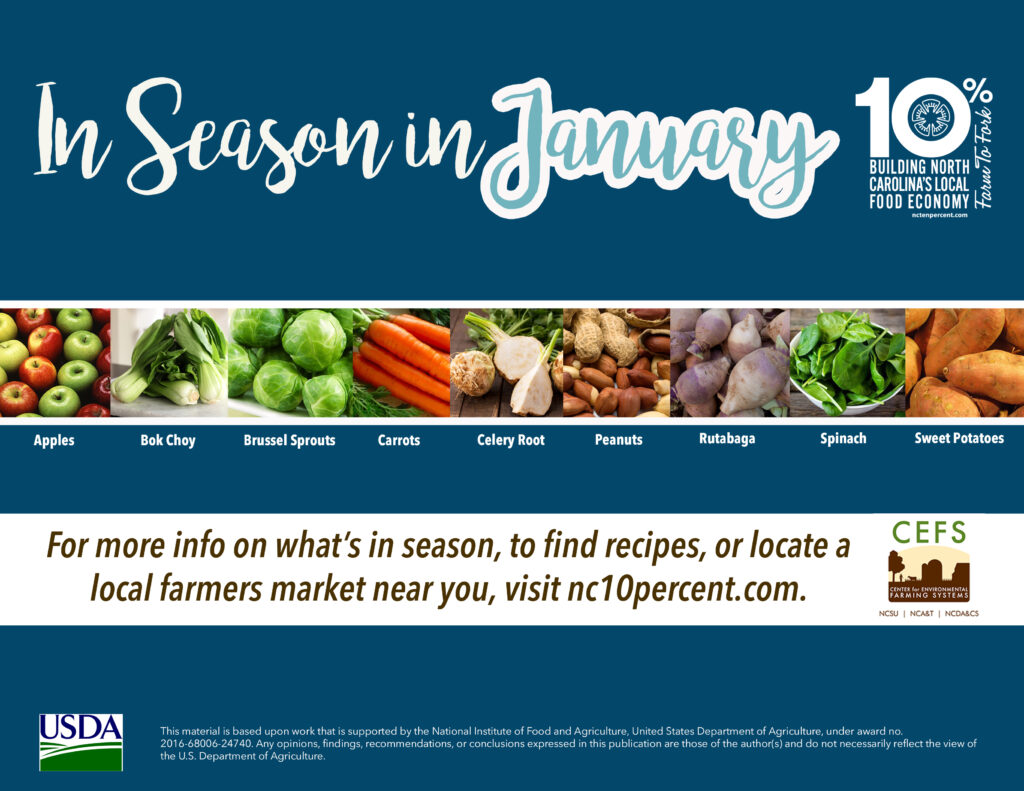It’s January, What’s in Season?
go.ncsu.edu/readext?977594
en Español / em Português
El inglés es el idioma de control de esta página. En la medida en que haya algún conflicto entre la traducción al inglés y la traducción, el inglés prevalece.
Al hacer clic en el enlace de traducción se activa un servicio de traducción gratuito para convertir la página al español. Al igual que con cualquier traducción por Internet, la conversión no es sensible al contexto y puede que no traduzca el texto en su significado original. NC State Extension no garantiza la exactitud del texto traducido. Por favor, tenga en cuenta que algunas aplicaciones y/o servicios pueden no funcionar como se espera cuando se traducen.
Português
Inglês é o idioma de controle desta página. Na medida que haja algum conflito entre o texto original em Inglês e a tradução, o Inglês prevalece.
Ao clicar no link de tradução, um serviço gratuito de tradução será ativado para converter a página para o Português. Como em qualquer tradução pela internet, a conversão não é sensivel ao contexto e pode não ocorrer a tradução para o significado orginal. O serviço de Extensão da Carolina do Norte (NC State Extension) não garante a exatidão do texto traduzido. Por favor, observe que algumas funções ou serviços podem não funcionar como esperado após a tradução.
English
English is the controlling language of this page. To the extent there is any conflict between the English text and the translation, English controls.
Clicking on the translation link activates a free translation service to convert the page to Spanish. As with any Internet translation, the conversion is not context-sensitive and may not translate the text to its original meaning. NC State Extension does not guarantee the accuracy of the translated text. Please note that some applications and/or services may not function as expected when translated.
Collapse ▲
It’s January and temperatures have dropped outside. Gardens and fruit and vegetable farms in Western North Carolina have been put to bed, waiting for spring. However, there are still plenty of vegetables in season and available in North Carolina at our regional WNC Farmers Market and local roadside stands.
As we kick off the new year, many including myself are motivated to start 2024 with a focus on maintaining or improving our health. While I personally do not make specific resolutions each year I do enjoy the excitement and motivation that come with the new year and use that momentum to examine my personal health goals; see what is working and change what is not.
Increasing your fruit and vegetable intake is a great way to improve your health and try out some fresh, delicious local fruits and vegetables. The most important thing to remember when setting health goals is to keep it simple. Taking on too much at one time can lead to failure. Improve your diet by making one change such as getting at least 2 ½ cups of vegetables a day. I recommend planning menus by starting with the vegetables and building the rest of the meal around that. Once you have mastered 2 ½ cups of vegetables a day, try another healthy challenge like getting at least 2 cups of fruit a day. Check out the myplate.gov website for information on choosing a healthy plate.
The following Spinach Salad with Peanuts and Apples recipe incorporates three of the items on the list of In Season in January in North Carolina.

Peanuts- According to the N.C. Plant Sciences Initiative, North Carolina produces about 441 million pounds of peanuts a year on over 100,000 acres of land. This accounts for 9% of the peanuts produced in the United States. The majority of these peanuts are a Virginia variety, a large, crunchy, snacking peanut.
Apples – Currently, North Carolina ranks No. 7 in the U.S. in Apple production producing roughly 4 million bushels of apples (well north of 150 million pounds) in any given year. Henderson County leads the charge, growing roughly 80% of the state’s crop. According to the National IPM Database, North Carolina has four primary apple production regions, all in the western part of the state and each with a different geography and climate. After Henderson County, the second largest production region is the Wilkes/Alexander County area. The third region is the Cleveland/Lincoln County area which includes the lowest elevation area in North Carolina with orchards in the 4th area, Haywood County, having the highest elevation, the shortest growing season and the coolest temperatures.
Spinach – It’s readily available, it’s loaded with nutrients and it’s versatile! Spinach can be served fresh as a salad, sautéed as a side dish, incorporated into soups, appetizer dips, pastas or bowl recipes. It can be purchased fresh, canned or frozen. Spinach contains high amounts of insoluble fiber, vitamins A, C and K, folic acid, iron and calcium. Spinach benefits eye, bone and heart health and it naturally regulates blood pressure.
For more information on Local Foods in North Carolina visit nc10percent.com .




